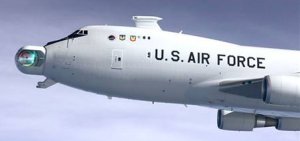This article is more than 1 year old
US gov's flying laser hit by delays, problems
Aerial raygun flotilla scheme savaged
US government researchers have highlighted serious problems with the Pentagon's controversial Airborne Laser (ABL) programme.
The ABL project is intended to produce a high-powered, chemically-fuelled laser weapon which would be capable of blasting hostile ballistic missiles out of existence shortly after launch.
In order to get the laser weapon into the vicinity of possible enemy missile silos, it is to be mounted in a 747 jet, one of the few aircraft capable of lifting such bulky machinery.

The ABL: missile-frying stratosphere laser cannon.
The initial raygun-toting jumbo, which has a lot of its equipment already fitted (though not yet the actual missile-busting laser) recently visited Washington in an effort to drum up support on Capitol Hill - an event which may have prompted the Congressional Research Service (CRS) to update its files on the ABL. A fresh CRS report on the laser program was issued on July 9.
CRS reports aren't published openly, but they often find their way into the public domain. Aviation Week & Space Technology ran an analysis of the ABL document today, and the full text is available online (pdf) from the Federation of American Scientists.
The authors of the report, defence wonks Christopher Bolkcom and Steven Hildreth, say that the ABL program has been dogged by delays and that the technology may not be sufficiently mature.
"The primary goal to have achieved a lethality test by 2005 was not met," they write. "That test has now been moved further to August 2009. Program officials said the delay was due largely to program restructuring and budget changes. Others suggested that technical and integration problems continue to prove more challenging than anticipated."
There are also worries about how much the blaster-plane might cost. This is a hard thing to pin down, seemingly.
"The total ABL program cost cannot be given or estimated because of the acquisition strategy ... the total number of ABL aircraft to be procured has not been determined," says the report.
It seems that in 1997 the plan was for seven jumbos costing a total of $6.12bn. This has now risen to $10.7bn: or maybe a lot more. It seems that the Pentagon's missile-defence chief, General Trey Obering, has told Congress that "it is too early to tell how much the ABL will cost to operate because program managers do not know what technical achievements will be made in the coming years."
Even if the laser plane can be made to work, and the US government can afford it, there are still problems ahead.
"Questions remain about the number of aircraft to be procured, where the aircraft might be deployed, and how they would be used," say Bolkcom and Hildreth.
"On-station time for the ABL is premised on forward basing ... bases would likely not have chemical replenishment capabilities, which would necessitate return flights to the United States if the laser is used ... a force of seven aircraft might only be expected to provide 24-hour coverage of one theater."
So, for instance, if the American aerial-raygun flotilla were all watching North Korea, the Iranians might get out of hand. Anyway, it seems that only two laser jumbos are planned at present. This, according to the CRS men,
"brings the issue of exactly what a small number of ABL aircraft — in this case two — could achieve operationally."
And it seems that the ABL is expected to achieve effective range of 400km or so at most. This is actually quite impressive, but the report notes that it makes the system hard to use against Russia and China - the only ballistic-missile threats facing the USA at the moment.
"Would the ABL fly into these countries’ airspace during crisis?" ask the authors.
That would certainly be a gutsy call. But if the jumbo and its fighter escort can't get in range of missile silos, it won't be much use. That said, the Pentagon has always said that its entire missile-defence program - of which the ABL is only one part - is not intended to prevent a massive Russian strike, only a relatively limited one from an enemy on the order of Iran.
All in all, though, it seems that the day of the flying raygun may be a way off yet. ®
